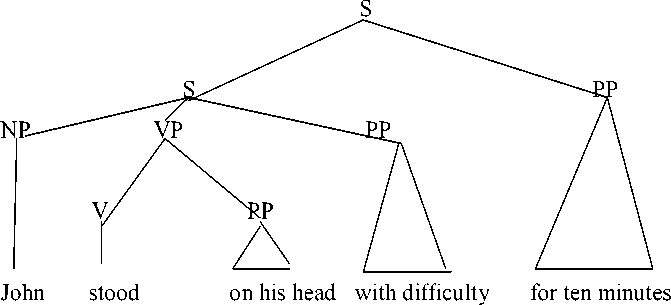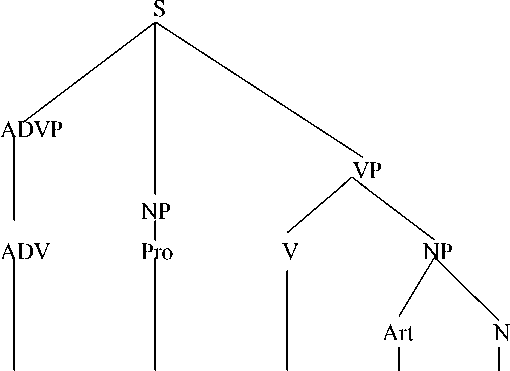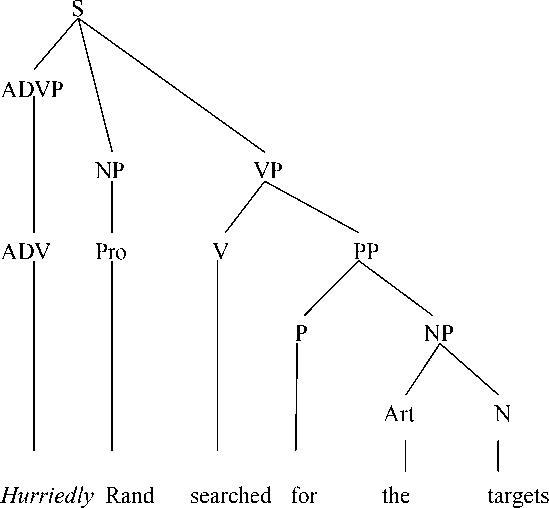THE ANALYSIS OF ADVERBIAL OF MANNER FOUND IN THE NOVEL “KNIFE OF DREAMS” BY ROBERT JORDAN
on
1
THE ANALYSIS OF ADVERBIAL OF MANNER FOUND IN THE NOVEL “KNIFE OF DREAMS” BY ROBERT JORDAN
I Made Juliarta
Jurusan Sastra Inggris Fakultas Sastra Unud
Abstrak
Di dalam kalimat terdapat kata keterangan cara yang berfungsi untuk memodifikasi kata kerja, kata sifat, dan kalimat. Ada dua bentuk kata keterangan cara, yaitu kata keterangan cara yang bisa diisi dalam bentuk kata keterangan cara yang berakhiran –ly dan kata keterangan cara dalam bentuk ungkapan kata depan. Juga menjelaskan fungsi dari kata keterangan cara di setiap kalimat tersebut. Data ini menggunakan metode penelitian kualitatif. Data diambil dari novel berjudul “knife of dreams” yang ditulis oleh Robert Jordan.
Kata Kunci: Kata tindakan keterangan cara, ungkapan kata depan, dan kalimat.
A sentence is a grammatical unit consisting of one or more words. Words express an idea, a question, subject and statements and usually contain a subject and a verb. Many sentences build sentences which are united as one. Phrases and sentences are built up of constituent series (syntactic units), which serve as grammatical function. An adverb is a word that changes the meaning of a verb, adjective, and sentence. Adverbs are words like hurriedly, quickly, slowly, and instantly. It modifies a verb or verb phrase. An adverb provides information about the manner, time, place, frequency, or certainty. Brown and Miller (1992:95) describes that adverbial of manner indicate the manner in which the event is described by the verb. Adverbial of manner shows how an action is performed. There are some variations of its form. Adverbial of manner can be formed in the form of adverb phrase and prepositional phrase. Analyzing sentence into its constituents is usually done in English. Using the constituent structure presentation, the adverbial of manner can also be analyzed. The sentence structure could be known as syntactical identification by identifying and analyzing the constituent.
Based on the problems above, there are some problems which can be analyzed as follows:
-
1. What forms of adverbial of manner are found in the novel entitled “Knife of Dreams” by Robert Jordan?
-
2. What positions of adverbial of manner are found in the sentence structure?
-
3. Aim of the Study
Based on the problems above, this study aimed at:
-
1. Analyzing the forms of adverbial of manner found in the novel “Knife of Dreams”by Robert Jordan.
-
2. Analyzing the positions of adverbial of manner found in the sentence structure.
In this writing, the research method consists of data source, method and technique of collecting data (how to collect the data), and method and technique of analyzing data (how to analyze the data collected). The data sources and method and technique of collecting data are the procedures used to find out certain objects.
The data were taken from the novel “Knife of Dreams” by Robert Jordan. This novel was chosen as the data source because it contains a lot of adverbial of manner words which relate to the topic of this writing. Besides, there are many kinds of forms of adverbial of manner which can be found in this novel.
The technique of collecting data was done through library research. The method and technique of collecting data was conducted by documentation method. The data were taken from the novel with the documentation method in order to get some adverbial of manner words. There are two steps in collecting
data. First, it is important to get words of adverbial of manner by reading novel repeatedly.
Qualitative method is used in analyzing data. It was important to analyze the collected data descriptively based on the theoretical framework. First, the data were classified and analyzed, based on the forms of adverbial of manner. Based on the theory proposed by Brown and Miller (1991), the form of adverbial of manner was analyzed. It would be classified into the form of adverbial of manner (adverbial of manner which can be filled in the form of adverb of manner and adverbial of manner in the form of prepositional phrase). The form of adverbial of manner was presented using this tree diagram presentation.
In a sentence, adverbial of manner can be filled in the form of adverb of manner and prepositional phrase. According to Brown and Miller (1991:95) that adverbial of manner is the item that most readily spring to mind as examples of the adverb class, especially those formed by the affixation of –ly to a corresponding adjective form. According to Brown and Miller (1992:95) adverbials of manner are the items that most readily spring to mind as examples of the class adverb, especially those formed by the affixation of –ly to a corresponding adjective form:
-
1. Happy ----------------> happily (Brown and Miller, 1991:95)
-
2. Vicious -----------------k viciously (Brown and Miller, 1991:95)
Adverbials also take the form of prepositional phrase. The form of adverbial of manner in the prepositional phrase is characterized by the preposition as the head of adverbials of manner. According to Brown and Miller (1992:94) adverbials of manner are typically a prepositional phrase:
-
1. The man beat the dog in a vicious manner (Brown and Miller, 1991:94)
-
2. The man beat the dog with apparent enjoyment (Brown and Miller, 1991:94)
According to Brown and Miller (1991:97) adverbs are modifier and that to some extent the scope of the modification can be caught in constituent structure representations. This can be captured in constituent structure diagrams of the kind shown, which also illustrates the fact that the same category, PP, can occur in variety of functions-as the strict subcategory of a verb, as a VP adverb and as a sentence adverbial.

Verb adverbial adverbial of time
Subcategorizer of manner
In a sentence, the form of adverbial of manner is presented into the constituent structure representation. This chapter will discuss about the form of adverbial of manner in a sentence and the constituent structure analysis of it.
The second theory proposed by Quirk and Greenbaum (208:1973) describes about the position of adverbial of manner. Those are: initial position, medial position, and final position.
Adverbial of manner can be in the form of adverb of manner which occurs in the initial, medial, and final position. Some data below show the adverbial of manner that can be filled in the form of adverb of manner which occurs in the initial, medial and final position.
Adverbial of manner can be in the form of adverb of manner in the initial position, those are:
-
1. Hastily she released the source (Jordan, 2005:505)

Hastily She released the source
-
a. Form
The adverbial of manner in the constituent structure above can be filled in the form of adverb of manner. Hastily is the adverb of manner which fills the position of adverbial of manner. This adverb comes before the subject which is used to put emphasis on how she released the source. Hastily is an adverb of manner which is derived from an adjective haste and added with –ly suffix. In the process of the suffixation, adverb of manner is formed by: haste + (-ly) suffix. Therefore, it becomes hastily.
It can be explained from the constituent structure above that a sentence has two major constituents. They are ADVP and S. It can be seen that the constituent structure of sentence She release the source is divided into the NP and VP. The NP she and VP released the source are parts of the constituent structure above. An adverb of manner hastily consists of a single word. It is optional because the sentence is well formed although it occurs without the presence of adverb hastily. It also functions as modifiers to the nucleus she released the source. It is the sister of the nuclear sentence She released the source. The NP She is followed by the VP released and the NP the source. The NP the source is divided into two constituents. They are article the and noun source.
-
b. Position
An adverb of manner that fills the position of adverbial of manner in the constituent structure above is placed in the initial position (I). It is placed before the subject She of the sentence.
-
2. Hurriedly Rand searched for the targets (Jordan, 2005:445)

a. Form
Hurriedly is an adverb of manner that comes before the subject. This adverb is used to explain about in what way he searched for the targets. Hurriedly is an adverb of manner which is derived from an adjective hurried and added with –ly suffix. In the process of the suffixation, adverb of manner is formed by: hurried + (-ly) suffix becoming hurriedly.
The constituent structure indicates that a sentence has two major constituents, those are ADVP and S. The ADVP consists of one constituent in the form of ADV hurriedly. It is optional because the sentence is well formed without the presence of adverb hurriedly. It also functions as modifiers to the nucleus Rand searched for the targets. It can be concluded from the constituent structure above that the constituent structure of sentence Rand searched for the targets is divided into the NP and VP. The NP Rand and VP searched for the targets are
part of the constituent structure above. The NP Rand is followed by the VP searched and the NP the targets. The NP the targets is divided into two constituents. They are article the and noun targets.
b. Position
Hurriedly is an adverb of manner which occurs in the initial of the sentence. It is called the initial of the sentence because it is placed before the subject Rand of the sentence. Therefore an adverb of manner hurriedly in the constituent structure above is called in the initial of the sentence.
-
3. Happily his leers were directed (Jordan, 2005:408)

Happily his leers were directed
-
a. Form
Happily is an adverb of manner which fills the position of adverbial of manner. This adverb comes before the subject which is used to put emphasis on what way his leers were directed. Happily is an adverb of manner which is derived from the adjective happy and added with –ly suffix. In the process of the suffixation, adverb of manner is formed by: happy + (-ly) suffix becoming happily.
It can be concluded from the constituent structure above that a sentence has two major constituents, those are ADVP and S. The ADVP consists of one constituent in the form of ADV happily. It is optional because it is not required by
the verb of a sentence to form a well structured sentence. It also functions as modifiers of the nucleus his leers were directed. The adverbial of manner happily is VP modifiers. It can be concluded from the constituent structure above that the constituent structure of sentence his leers were directed is divided into the NP and VP. The NP his leers and VP were directed are parts of the constituent structure above. The NP his leers is followed by the VP were directed.
-
b. Position
The position of an adverb of manner happily in the sentence above is in the initial position. It is placed before the subject his leers of the sentence. Therefore, an adverb of manner happily in the constituent structure above is called in the initial of the sentence.
Based on the previous discussion and analysis, there are some points which can be drawn as conclusion. There are two forms of adverbial of manner. Those are adverbial of manner which can be filled in the form of adverb of manner and prepositional phrase. Adverbial of manner can be formed by adding – ly to the corresponding adjectives. The suffix –ly is added to the positive form of the adjective. The addition of –ly to the adjectives kind and simple produces the adverbs kind-ly and simp-ly. As a rule, it is possible to derive an adverb by adding the suffix –ly to an adjectival base.
Halliday, M.A.K., 1985. An Introduction to Functional Grammar. London: Edward
Huddleston, Rodney and Pullum, Geoffrey K. 2005. A Student’s Introduction to English Grammar. Canbridge: Cambridge University Press
Mukti, Hilman Fariz. 2002. Complete English Grammar. Yogyakarta: Ansolut.
Nuryanti. 2007. Adverbs and its Syntactic Function with Special reference to
Danielle Steel’s Daddy. Denpasar: Udayana University.
Rathadi. 2009. The Analysis of Adverb of Degree in Charlotte’s Web Novel. Denpasar: Udayana University.
Susnawati K. 2006. The Analysis of Manner Adjunct in The Witness by Sandra Brown. Denpasar: Udayana University.
Thomson, A.J. 1986. A Practical English Grammar. London: Oxford
University
Press.
Quirk R and Greenbaum. 1973. A University Grammar of English. Hongkong: Commonwealth Printing Press.
Petrus. 2005. The Morphosyntactic Analysis of –ize, -ify, and –en in English. Denpasar: Udayana University.
Wiryawan I G M. 2009. Derivational Suffixes in Jhon Grisham’s Novel “The Testament”. Denpasar: Udayana University.
Brown K and Miller J. 1991. A Linguistic Introduction to Sentence Structure.
London: Routledge.
Broccias C. 2011. Motivating the Flexibility of Oriented –ly Adverbs”. Dis. (serial online), Jan-Mar, (cited 2011 Jun. 56. Available from URL:
Discussion and feedback